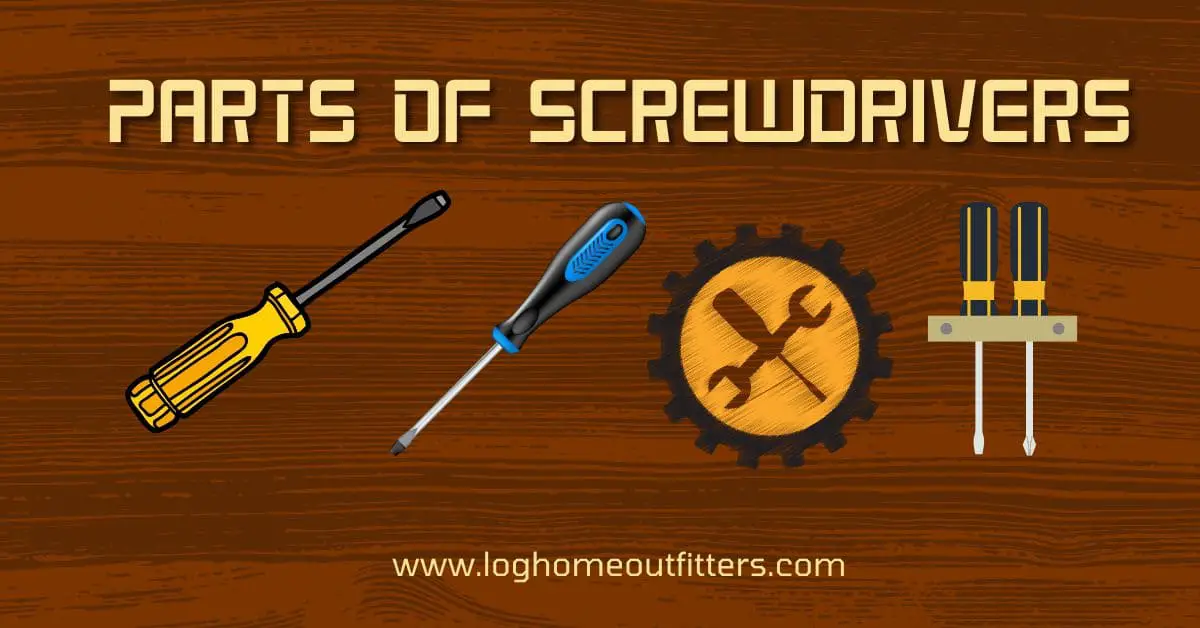fellow woodworking enthusiasts, to a captivating exploration into the world of tools and craftsmanship. Today, we embark on a journey that unveils the inner workings of a tool that holds a special place in every artisan’s toolbox: the screwdriver.
Whether you’re a seasoned craftsman or an aspiring DIY enthusiast, understanding the inner workings of this humble yet indispensable tool can significantly enhance your woodworking prowess.
As an expert in the field of woodworking, I invite you to join me in unraveling the intricacies of this unassuming yet indispensable instrument. Together, we will delve deep into the various parts that compose a screwdriver, shedding light on their functions and unveiling the secrets that make this tool an essential companion for any woodworking project.
So, grab hold of your preferred screwdriver and prepare to be enlightened by the fascinating world that lies within!
1. Handle:
Every screwdriver has a handle, which serves as the user’s grip and control point. The handle is typically made of wood, plastic, or rubber, providing a comfortable and ergonomic hold.
Its design may include ridges or contours to prevent slippage during use, ensuring a firm and secure grasp.
2. Shank:
The shank, also known as the blade, is the elongated rod-like portion of the screwdriver that connects the handle to the tip. It is usually made of high-quality steel, which imparts strength, durability, and resistance to bending or breaking.
The shank’s length and diameter can vary, allowing for versatility in applications and accommodating different screw sizes.
3. Tip:
The tip of a screwdriver is the crucial component that engages with the screw head. It comes in various shapes and types, each tailored to specific screw heads. Some common tip types include:
a. Flathead/Slotted:
This tip features a simple, flat, and straight design with a single slot, which corresponds to the flathead screw. It is widely used in woodworking and general applications.
b. Phillips:
The Phillips tip consists of a cross-shaped design, featuring four arms meeting at a central point. It is intended for use with Phillips-head screws, commonly found in electronic devices and machinery.
c. Pozidriv:
Similar to the Phillips tip, the Pozidriv has additional smaller cross-shaped grooves between the arms. It offers enhanced grip and reduced cam-out, making it suitable for high-torque applications.
d. Torx:
The Torx tip features a six-pointed star shape, providing better torque transfer and reduced slippage. It is often used in automotive and electronics industries.
4. Shank and Handle Connection:
The connection between the shank and the handle plays a vital role in the screwdriver’s overall strength and stability. The most common types of connections include:
a. Tang Connection: In this traditional design, the shank extends through the handle, forming a tang at the end. The tang is either secured by compression or by a ferrule, ensuring a sturdy connection.
b. Hexagonal Bolster Connection: This modern design incorporates a hexagonal bolster at the base of the handle, allowing the shank to fit tightly. The bolster provides added torque and prevents twisting during heavy-duty applications.
5. Shaft:
The shaft, located between the shank and the tip, is a cylindrical section that assists in transmitting torque from the handle to the tip. It provides rigidity and stability, preventing flexing or bending during use.
6. Magnetic Tip (Optional):
Some screwdrivers feature a magnetic tip, which utilizes a small magnet to attract and hold screws securely. This feature can be particularly helpful when working in tight spaces or when handling small screws that are difficult to grip manually.
What are the parts of an electric screwdriver?
1. Housing:
The housing, or casing, of an electric screwdriver is the outer protective structure that encloses all the internal components.
It is typically made of durable and lightweight materials such as plastic or metal. The housing not only provides physical protection but also offers ergonomic design features for comfortable handling during prolonged use.
2. Motor:
At the heart of an electric screwdriver lies its powerful motor. The motor converts electrical energy into rotational force, which drives the screwdriver’s operation.
Depending on the model and power rating, electric screwdrivers may have brushed or brushless motors. Brushless motors tend to be more efficient, durable, and produce less heat, resulting in extended battery life and superior performance.
3. Battery:
Unlike manual screwdrivers, electric screwdrivers rely on rechargeable batteries to provide the necessary power.
Lithium-ion (Li-ion) batteries are commonly used due to their high energy density, lightweight nature, and minimal self-discharge. The battery is usually integrated into the handle or can be detachable, allowing for easy replacement and recharging.
4. Trigger:
The trigger is the control mechanism of an electric screwdriver, located on the handle.
It enables the user to start and stop the rotational motion of the screwdriver. By applying pressure to the trigger, you can precisely control the speed and direction of the tool, allowing for delicate or rapid screwdriving as needed.
5. Chuck:
The chuck is the component that holds the screwdriver bits securely in place. It features a mechanism that allows for easy bit changes and ensures a firm grip.
The most common type of chuck used in electric screwdrivers is a keyless chuck, which can be operated by hand without the need for additional tools.
6. Bit Holder:
The bit holder is a removable attachment that connects to the chuck and holds the screwdriver bits.
It allows for quick and effortless swapping of different types and sizes of bits, accommodating various screw heads and applications. Some electric screwdrivers may have a magnetic bit holder, enhancing convenience by securely holding the bits in place during operation.
7. LED Work Light:
Many electric screwdrivers are equipped with built-in LED work lights. These lights illuminate the work area, providing enhanced visibility, especially in dimly lit spaces or when working in confined corners.
The LED light ensures accurate screw placement and reduces the chances of errors or mishaps.
Screwdriver uses and function
When it comes to the world of tools and woodworking, few instruments boast the versatility and indispensability of the humble screwdriver.
Whether you’re a seasoned craftsman, a DIY enthusiast, or simply someone with a penchant for fixing things, understanding the myriad uses and functions of screwdrivers is key to unlocking your potential as a skilled handyman.
we embark on a journey to explore the wide-ranging applications of screwdrivers, from basic assembly tasks to intricate woodworking projects. So, grab your trusty screwdriver and let’s delve into the fascinating world of its uses and functions!
1. Driving and Removing Screws:
The primary and most apparent purpose of a screwdriver is to drive and remove screws. By engaging the screw head with the appropriate tip of the screwdriver, you can exert torque to secure or release the screw from a material.
This function is essential for assembling furniture, fixing appliances, installing hardware, and countless other tasks that involve fastening or unfastening screws.
2. Woodworking:
Screwdrivers find a special place in the realm of woodworking, where precision and control are paramount. They are widely used to secure wooden components together, such as joining planks, fastening hinges, or attaching handles to cabinets.
The ability to adjust the torque applied with a screwdriver ensures the proper alignment and structural integrity of the woodworking project.
3. Electrical Work:
In electrical work, screwdrivers play a crucial role in connecting wires, securing electrical boxes, and installing switches and outlets.
They are instrumental in safely tightening terminal screws, ensuring reliable electrical connections without damaging delicate components.
4. Automotive Applications:
Screwdrivers are indispensable tools for automotive enthusiasts and professionals alike. They are used for various tasks, including removing interior panels, tightening or loosening bolts, adjusting engine components, and installing car accessories.
Different types of screwdrivers, such as Torx or Phillips, cater to the specific screw heads commonly found in automotive applications.
5. Electronics and Small Appliances:
The intricate world of electronics and small appliances relies heavily on screwdrivers for repair and maintenance. From opening the casing of smartphones and laptops to replacing batteries in remote controls or fixing circuit boards, screwdrivers provide the precision required to handle delicate screws and components.
6. DIY and Home Improvement:
For DIY enthusiasts and homeowners, screwdrivers are essential for a wide range of projects.
They come in handy for assembling furniture, installing shelves, hanging artwork, securing loose hinges or handles, and performing general repairs around the house. The versatility of screwdrivers makes them a go-to tool for various home improvement tasks.
7. Precision Instrument Repair:
Screwdrivers with smaller tips and sizes are employed in repairing precision instruments like watches, eyeglasses, cameras, and other delicate devices. The precision and control offered by screwdrivers allow for intricate and fine adjustments, ensuring that these valuable instruments are handled with care.
What are the types of woodworking screwdrivers?
We delve into the world of woodworking screwdrivers, exploring their various types and specializations.
From traditional hand tools to modern power-driven counterparts, understanding the different types of woodworking screwdrivers empowers craftsmen to select the perfect tool for each woodworking task.
So, let’s dive into this comprehensive guide and discover the essential types of woodworking screwdrivers!
1. Slotted Screwdrivers:
Slotted screwdrivers, also known as flathead screwdrivers, feature a flat, straight tip that fits into slotted screw heads. They are the most basic and widely used type of screwdriver in woodworking.
Slotted screwdrivers come in various sizes, corresponding to the width and depth of the slot in the screw head.
They are ideal for general woodworking applications and are commonly used in furniture assembly, cabinetry, and other projects that utilize slotted screws.
2. Phillips Screwdrivers:
Phillips screwdrivers are characterized by a cross-shaped tip with four arms meeting at a central point. They are designed specifically for Phillips-head screws, which have a corresponding cross-shaped indentation in their heads.
Phillips screwdrivers are prevalent in woodworking and are commonly found in furniture, cabinetry, and other applications where quick and secure fastening is desired. They provide better grip and reduce the likelihood of cam-out (slippage) during operation.
3. Pozidriv Screwdrivers:
Pozidriv screwdrivers are an advanced version of the Phillips screwdriver, featuring additional smaller cross-shaped grooves between the main arms of the tip.
These grooves provide increased grip and reduce the chances of cam-out, making Pozidriv screwdrivers ideal for high-torque woodworking applications.
They are commonly used in projects involving hardwoods, dense materials, or situations requiring greater screw-driving power and control.
4. Square Drive Screwdrivers:
Square drive screwdrivers, often referred to as Robertson screwdrivers, have a square-shaped tip that engages with square drive screws.
Square drive screws have a square recess in their heads, which provides excellent torque transfer and minimizes the risk of slippage or stripping.
Square drive screwdrivers are popular in woodworking, particularly for cabinetry, decking, and general construction projects. They excel in applications that require high torque and secure fastening.
5. Torx Screwdrivers:
Torx screwdrivers feature a six-pointed star-shaped tip, specifically designed for Torx-head screws. Torx screws have a corresponding star-shaped indentation in their heads, allowing for enhanced torque transfer and reduced slippage during operation.
Torx screwdrivers are commonly used in woodworking projects involving composite materials, laminates, and hardwoods. They are also prevalent in the automotive and electronics industries due to their ability to handle high-torque applications.
6. Specialty Screwdrivers:
In addition to the aforementioned types, there are various specialty screwdrivers designed for specific woodworking applications. Some examples include:
a. Cabinet Screwdrivers: These screwdrivers have an extended shank and a slim profile, allowing for easy access to screws in tight spaces within cabinets or furniture.
b. Jeweler’s Screwdrivers: Jeweler’s screwdrivers are miniature-sized with exceptionally small tips, designed for intricate woodworking tasks such as working on delicate wooden inlays or detailing.
c. Offset Screwdrivers: Offset screwdrivers feature a bent or angled shank, enabling access to screws in hard-to-reach areas or when working around obstacles.
d. Ratcheting Screwdrivers: Ratcheting screwdrivers have a mechanism that allows for continuous and rapid screwdriving without having to reposition the tool. They are ideal for projects requiring repetitive or continuous fastening.
Conclusion:
By unraveling the intricate parts of a screwdriver, we have gained a deeper understanding of this indispensable tool. From the handle and shank to the tip and shaft, each component plays a crucial role in ensuring effective and efficient screwdriving.
Armed with this knowledge, you can confidently choose the right screwdriver for your woodworking projects, maximizing your productivity and achieving superior results. So, go forth, equipped with your newfound understanding, and let your creativity and craftsmanship flourish!
FAQs
What are the main parts of a screwdriver?
A screwdriver typically consists of three main parts: the handle, the shank, and the tip. The handle provides a grip for the user, the shank connects the handle to the tip, and the tip engages with the screw head.
What materials are screwdriver handles made of?
Screwdriver handles are commonly made of wood, plastic, or rubber. These materials offer a comfortable grip and prevent slippage during use.
Some high-end screwdrivers may feature ergonomic designs or even incorporate materials like rubberized grips for added comfort.
Are there different types of screwdriver tips?
Absolutely! Screwdriver tips come in various shapes and types, each suited for specific screw heads.
Common tip types include flathead/slotted, Phillips, Pozidriv, and Torx. These tips ensure a proper fit and engagement with different screw heads, allowing for efficient and secure fastening.
What is the purpose of the shank in a screwdriver?
The shank serves as the connection between the handle and the tip. It is an elongated rod-like portion that provides stability and transfers torque from the handle to the tip.
The shank’s length and diameter can vary, accommodating different screw sizes and allowing for versatility in applications.
Do all screwdrivers have a magnetic tip?
No, not all screwdrivers have a magnetic tip. While some screwdrivers feature a magnetic tip, which can attract and hold screws securely, it’s not a universal feature.
The magnetic tip can be particularly useful when working in tight spaces or dealing with small screws that are difficult to handle manually.
Can the connection between the shank and the handle vary?
Yes, the connection between the shank and the handle can differ depending on the screwdriver design. Traditional screwdrivers often have a tang connection, where the shank extends through the handle, forming a tang that is secured by compression or a ferrule.
Modern designs may feature a hexagonal bolster connection, where the shank fits tightly into a hexagonal bolster at the base of the handle, providing added torque and preventing twisting during heavy-duty applications.
Are there any additional features to look for in a screwdriver?
While the basic components of a screwdriver are essential, there are additional features to consider based on your specific needs.
Some screwdrivers may have built-in LED lights to illuminate the work area, making it easier to see and work in low-light conditions.
Others may have cushioned or anti-vibration handles for enhanced comfort during prolonged use. It’s always a good idea to explore the different options available and choose a screwdriver that best suits your requirements.




